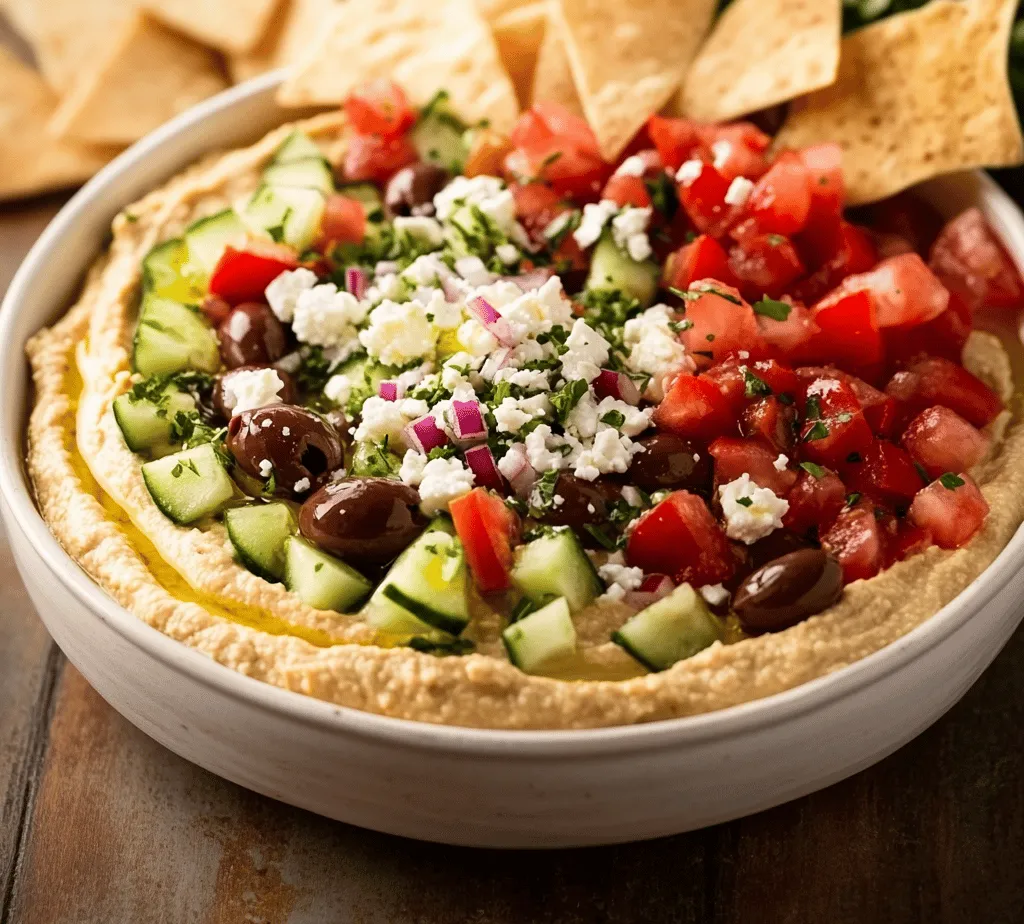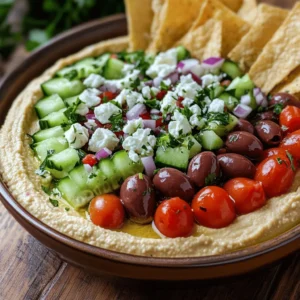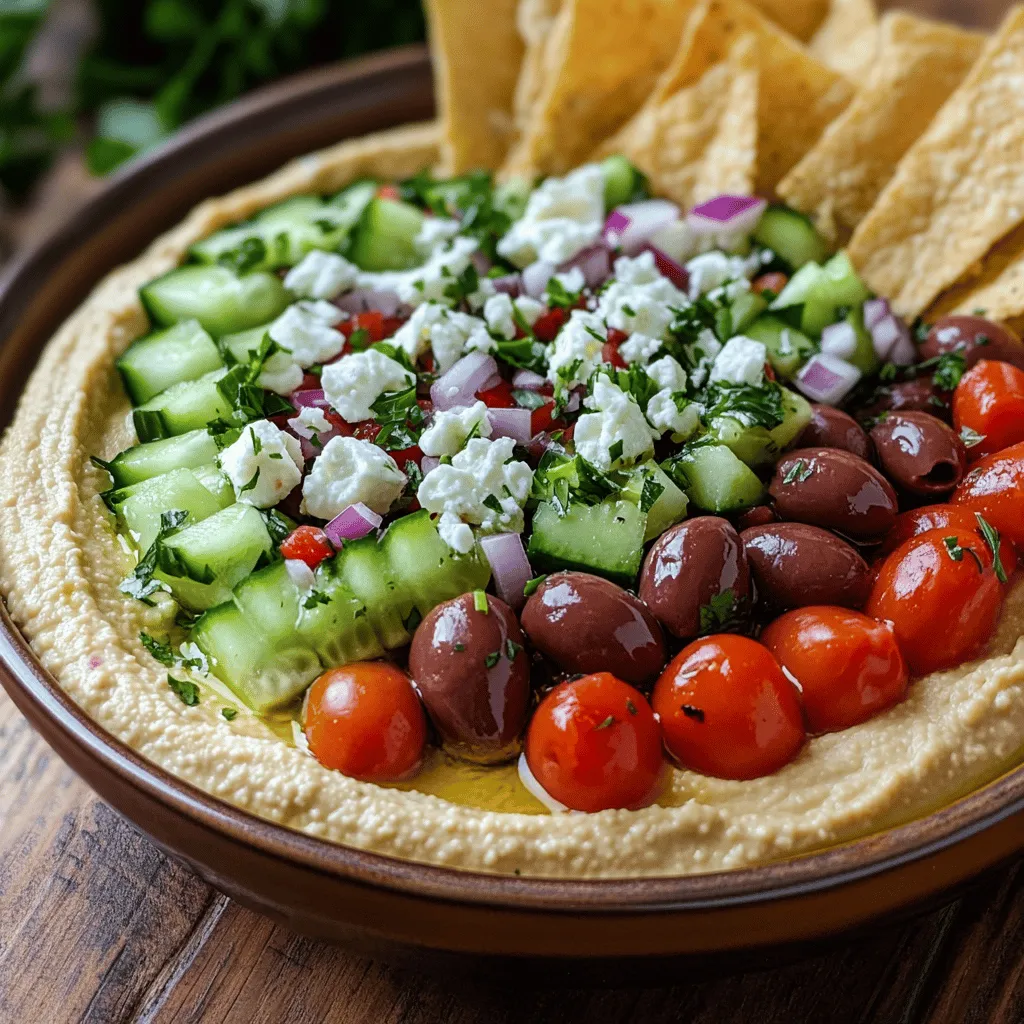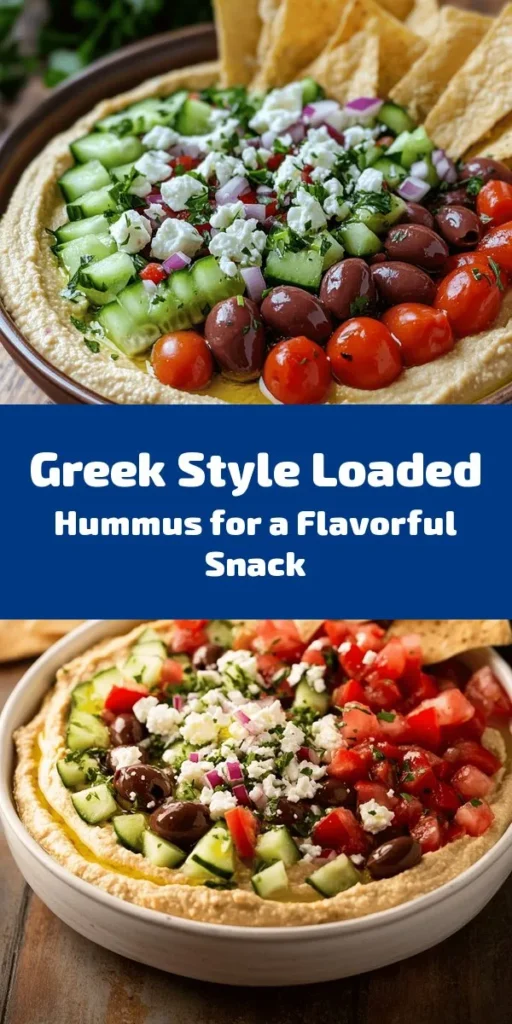Introduction
Greek Style Loaded Hummus is not just a dish; it’s a celebration of the rich flavors and vibrant colors of Mediterranean cuisine. This dish has gained tremendous popularity in recent years, becoming a staple for those seeking a healthy appetizer, snack, or even a light meal. The appeal of Greek Style Loaded Hummus lies in its ability to combine the creamy, nutty goodness of traditional hummus with fresh, zesty toppings that make it visually stunning and incredibly delicious.
As health-conscious eating trends continue to rise, this versatile dish stands out for its nutritious ingredients. Packed with protein from chickpeas, healthy fats from tahini and olive oil, and a variety of vitamins from fresh vegetables, it’s no wonder that Greek Style Loaded Hummus has become a favorite among health enthusiasts and foodies alike. Whether served at a party, enjoyed as a midday snack, or prepared as a light dinner, this dish is both satisfying and nourishing.
In this article, we invite you to explore the delightful recipe for Greek Style Loaded Hummus, highlighting its origins, ingredients, and step-by-step instructions to create this culinary masterpiece right in your own kitchen.
Understanding Hummus: A Mediterranean Staple
Hummus is a creamy dip that has its roots deeply embedded in Mediterranean and Middle Eastern culinary traditions. Often made from blended chickpeas, tahini, olive oil, lemon juice, and garlic, hummus is not only delicious but also nutrient-dense. It is a staple in many diets, celebrated for its versatility and health benefits.
The history of hummus can be traced back to ancient civilizations, where it was consumed as a source of sustenance and nourishment. Over the years, various regions have adapted the basic recipe, resulting in the numerous hummus variations we see today. Greek Style Loaded Hummus is one such variation that enhances traditional hummus with colorful toppings and bold flavors, making it a standout dish at any gathering.
The core ingredients of traditional hummus serve as the foundation for this Greek-inspired version. Chickpeas provide a creamy texture and a wealth of nutrients, while tahini contributes a rich, nutty flavor. By incorporating fresh vegetables and toppings like Kalamata olives and feta cheese, Greek Style Loaded Hummus elevates the classic dish to new heights, creating a delightful dining experience.
Ingredients Breakdown for Greek Style Loaded Hummus
To prepare Greek Style Loaded Hummus, you will need a variety of ingredients that not only add flavor but also contribute numerous health benefits. Below is a detailed breakdown of each component used in this recipe:
Chickpeas
Chickpeas are the star ingredient in hummus, providing a creamy base and a wealth of nutritional benefits. They are an excellent source of plant-based protein, making them a popular choice for vegetarians and vegans. Furthermore, chickpeas are high in dietary fiber, which aids in digestion and promotes a feeling of fullness. Their subtle, nutty flavor pairs perfectly with the other ingredients, creating a harmonious blend.
Tahini
Tahini is a paste made from ground sesame seeds and plays a crucial role in the flavor and texture of hummus. It adds a creamy richness and a distinct nutty flavor that enhances the overall taste of the dish. In addition to its flavor contributions, tahini is a source of healthy fats, vitamins, and minerals, making it a nutritious addition to this recipe.
Olive Oil
High-quality olive oil is essential for adding depth and richness to Greek Style Loaded Hummus. Known for its heart-healthy monounsaturated fats, olive oil not only enhances the flavor but also provides numerous health benefits, including anti-inflammatory properties and support for cardiovascular health. A drizzle of good olive oil on top of the hummus adds a finishing touch that elevates the dish.
Lemon Juice
The acidity of lemon juice is vital for balancing the flavors in Greek Style Loaded Hummus. It brightens the dish and cuts through the creaminess of the tahini and chickpeas, creating a well-rounded flavor profile. Additionally, lemon juice is packed with vitamin C and antioxidants, contributing to overall health and wellness.
Garlic
Garlic adds a robust flavor to hummus, giving it a distinctive kick. Known for its numerous health benefits, garlic is believed to support the immune system and provide anti-inflammatory properties. It also adds a savory depth to the dish that complements the other ingredients beautifully.
Cumin
Cumin is a spice often used in Mediterranean and Middle Eastern cooking, known for its warm, earthy notes. It enhances the flavor profile of hummus, adding a layer of complexity that makes it more enjoyable. Cumin is also rich in antioxidants and has been linked to various health benefits, including digestive support.
Greek Yogurt
Greek yogurt is another ingredient that elevates Greek Style Loaded Hummus. It adds a creamy texture and a slight tanginess that complements the other flavors. Additionally, Greek yogurt is high in protein and probiotics, making it a nutritious addition that supports gut health.
Fresh Vegetables (Cucumber, Tomatoes, Red Onion)
Fresh vegetables are vital for adding color, crunch, and freshness to Greek Style Loaded Hummus. Diced cucumber, juicy tomatoes, and crisp red onion provide a refreshing contrast to the creamy hummus base. These vegetables are also rich in vitamins and antioxidants, enhancing the nutritional profile of the dish.
Kalamata Olives and Feta Cheese
Kalamata olives and feta cheese are quintessential ingredients in Greek cuisine, offering briny flavors that enhance the overall taste of the hummus. Kalamata olives add a salty richness, while feta cheese contributes creaminess and a tangy flavor. Both ingredients not only elevate the dish but also provide healthy fats and protein.
Garnish and Serving Suggestions
To complete the dish, garnish Greek Style Loaded Hummus with fresh parsley for a pop of color and freshness. Serve it alongside pita chips, fresh vegetables, or crusty bread for dipping. This not only makes for a visually appealing presentation but also enhances the dining experience.
Step-by-Step Instructions for Preparing Greek Style Loaded Hummus
Creating Greek Style Loaded Hummus is a straightforward process that can be accomplished in just a few easy steps. Below are the detailed instructions to guide you through the preparation:
Preparing the Hummus Base
1. Gather Your Ingredients: Start by gathering all the necessary ingredients for the hummus base: canned chickpeas (drained and rinsed), tahini, high-quality olive oil, fresh lemon juice, minced garlic, ground cumin, and salt.
2. Blend the Ingredients: In a food processor, combine the chickpeas, tahini, olive oil, lemon juice, garlic, cumin, and salt. Blend until the mixture is smooth and creamy. You may need to scrape down the sides of the bowl a few times to ensure even blending.
3. Adjust Consistency: If the hummus is too thick, add a little water (1 tablespoon at a time) until you reach your desired consistency. The hummus should be smooth and spreadable.
4. Taste and Adjust Seasoning: Once blended, taste the hummus and adjust the seasoning as needed. You may want to add more salt, lemon juice, or garlic to suit your preferences.
Creating the Greek Salad Topping
1. Prepare the Vegetables: While the hummus is blending, prepare the toppings by dicing fresh cucumber, tomatoes, and red onion into small pieces. Aim for a uniform size to ensure an even distribution over the hummus.
2. Mix the Toppings: In a medium bowl, combine the diced cucumber, tomatoes, and red onion. Drizzle with a little olive oil and season with salt and pepper. Toss to combine, allowing the flavors to meld together.
3. Add Olives and Feta: Chop the Kalamata olives and crumble the feta cheese. Mix them into the vegetable mixture, ensuring they are evenly distributed.
4. Assembly: To assemble your Greek Style Loaded Hummus, spread the hummus evenly on a serving platter or in a bowl. Top with the Greek salad mixture, ensuring an even layer of vegetables, olives, and feta.
With these steps completed, your Greek Style Loaded Hummus is ready to impress! Stay tuned for the next part of this article, where we will explore additional tips for the best results and answer some common questions about this delightful dish.

Layering the Dish
As you prepare to assemble your Greek Style Loaded Hummus, it’s essential to consider the visual appeal alongside the delicious flavors. Begin by taking your creamy hummus base, which should be smooth and well-seasoned, and spread it generously across a large serving platter or shallow bowl. Aim for an even layer that creates a solid foundation for your toppings.
Next, take your Greek yogurt, which should be thick and tangy, and dollop it in the center of the hummus layer. Using the back of a spoon, gently swirl the yogurt into the hummus, creating a marbled effect. This not only enhances the presentation but also allows the flavors to meld beautifully together.
Now it’s time to add the salad topping. Prepare your fresh vegetables—cucumbers, tomatoes, and red onions—by finely chopping them and tossing them together in a bowl with a splash of lemon juice, a drizzle of olive oil, salt, and pepper. This simple dressing enhances the freshness of the veggies. Spoon this vibrant salad mixture evenly over the yogurt layer, ensuring a colorful display that highlights the fresh ingredients.
Finally, sprinkle crumbled feta cheese over the top, allowing it to nestle into the vegetables. The addition of feta not only adds a rich, salty flavor but also contributes to the dish’s overall aesthetic. For a final flourish, you can either lightly drizzle more olive oil across the top or sprinkle a bit of smoked paprika for an extra pop of color.
Final Touches
To elevate your Greek Style Loaded Hummus further, consider garnishing it with freshly chopped parsley or mint. These herbs not only add a vibrant green color but also infuse the dish with refreshing aromas. Scatter the herbs generously over the top, allowing their fragrance to enhance your dining experience.
Drizzling high-quality extra virgin olive oil around the edges of the dish can also enhance the visual appeal while adding a luxurious touch. Aim for a thin, even stream to create an inviting look that invites guests to dig in.
Serving Suggestions and Pairings
When it comes to serving your Greek Style Loaded Hummus, presentation is key. Arrange the platter in the center of the table, allowing everyone to take part in the experience. The vibrant colors and textures will draw attention, making it the star of your meal.
Ideal accompaniments include warm pita bread, which you can cut into triangles for easy dipping, or crunchy pita chips for a delightful contrast. Both options allow guests to scoop up generous portions of the hummus and toppings, making for an interactive dining experience.
For those looking to elevate the meal further, consider pairing your hummus with a light, crisp white wine, such as a Sauvignon Blanc or a Greek Assyrtiko. These wines complement the dish beautifully, enhancing the flavors without overpowering them. Alternatively, a refreshing sparkling water with a squeeze of lemon can also cleanse the palate and enhance the Mediterranean experience.
Exploring Variations and Customizations
One of the best aspects of Greek Style Loaded Hummus is its versatility. Feel free to experiment with alternative ingredients or toppings to suit your taste preferences or dietary restrictions. For example, if you’re looking to change up the base, consider using different types of beans, such as black beans or white beans, to create unique flavor profiles.
If tahini is not readily available or if you’re avoiding it due to allergies, you can easily substitute it with sunflower seed butter or even omit it altogether for a simpler hummus. Similarly, if you need a dairy-free option, you can replace Greek yogurt with a plant-based yogurt alternative, which is widely available in most grocery stores today.
When it comes to toppings, the possibilities are endless. Try adding roasted red peppers for a sweet and smoky flavor, or artichokes for a tangy twist. Avocado slices can also add a creamy texture that complements the other ingredients beautifully. You can even mix in spices like za’atar or sumac for an added flavor kick.
Health Benefits of Greek Style Loaded Hummus
Greek Style Loaded Hummus is not just a delicious dish; it also offers a range of health benefits. The primary ingredient, chickpeas, is an excellent source of plant-based protein and dietary fiber, which can help promote satiety and support digestive health. Additionally, chickpeas contain essential vitamins and minerals, including iron, magnesium, and vitamin B6.
The inclusion of fresh vegetables in the salad topping adds an abundance of vitamins, antioxidants, and phytonutrients that are vital for overall health. The tomatoes, cucumbers, and onions provide hydration and essential nutrients, making this dish not only filling but nourishing.
Healthy fats are another significant component of this dish, primarily from the olive oil and yogurt. Olive oil is renowned for its heart-healthy properties, thanks to its high levels of monounsaturated fats and antioxidants. Meanwhile, yogurt provides probiotics that support gut health, making this dish a well-rounded option for a balanced diet.
Cultural Significance of Hummus in Mediterranean Cuisine
Hummus holds a special place in Mediterranean cuisine, particularly in Greek and Middle Eastern cultures. It is often served as a meze, a selection of small dishes meant for sharing, fostering a sense of community and togetherness. In many households, hummus is a staple, enjoyed during family gatherings, celebrations, and festive occasions.
Historically, the origins of hummus can be traced back to the Middle East, with various countries claiming it as their own. Its simple yet flavorful ingredients make it a beloved dish across cultures, transcending borders and bringing people together over a shared love of food. In Greek culture, hummus is often paired with olives, bread, and other dips, creating a vibrant spread that showcases the region’s rich culinary heritage.
Fun anecdotes about hummus include its appearance in various international food festivals and competitions, where chefs showcase their unique takes on this classic dish. The versatility of hummus, combined with its deep cultural roots, makes it a beloved dish around the world.
Conclusion
In summary, Greek Style Loaded Hummus is a delightful and versatile dish that can easily become a favorite at any gathering. Its vibrant layers of flavor and texture, combined with the health benefits of its wholesome ingredients, make it a fantastic addition to your culinary repertoire. Whether you choose to enjoy it as an appetizer, a snack, or part of a larger meal, this dish encapsulates the essence of Mediterranean cuisine.
So, gather your friends and family around the table and enjoy the experience of making and sharing this delicious hummus. With its rich history and cultural significance, Greek Style Loaded Hummus is more than just a meal; it’s an invitation to explore the flavors and traditions of the Mediterranean. Embrace the joy of cooking and the art of sharing with this delightful dish that promises to bring everyone together.



